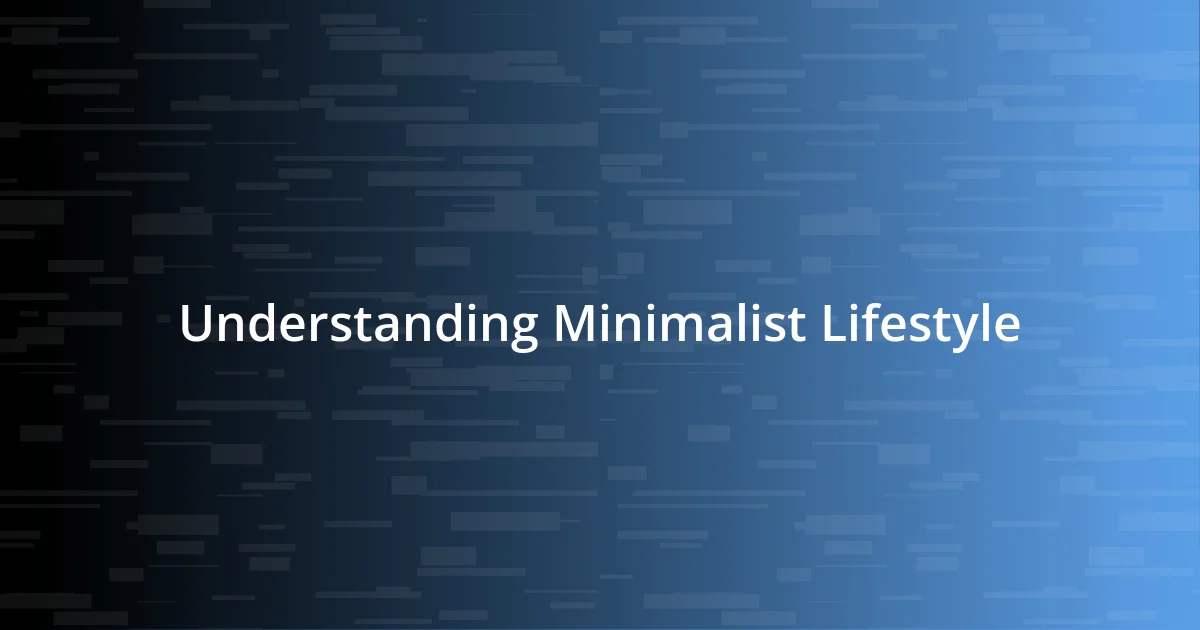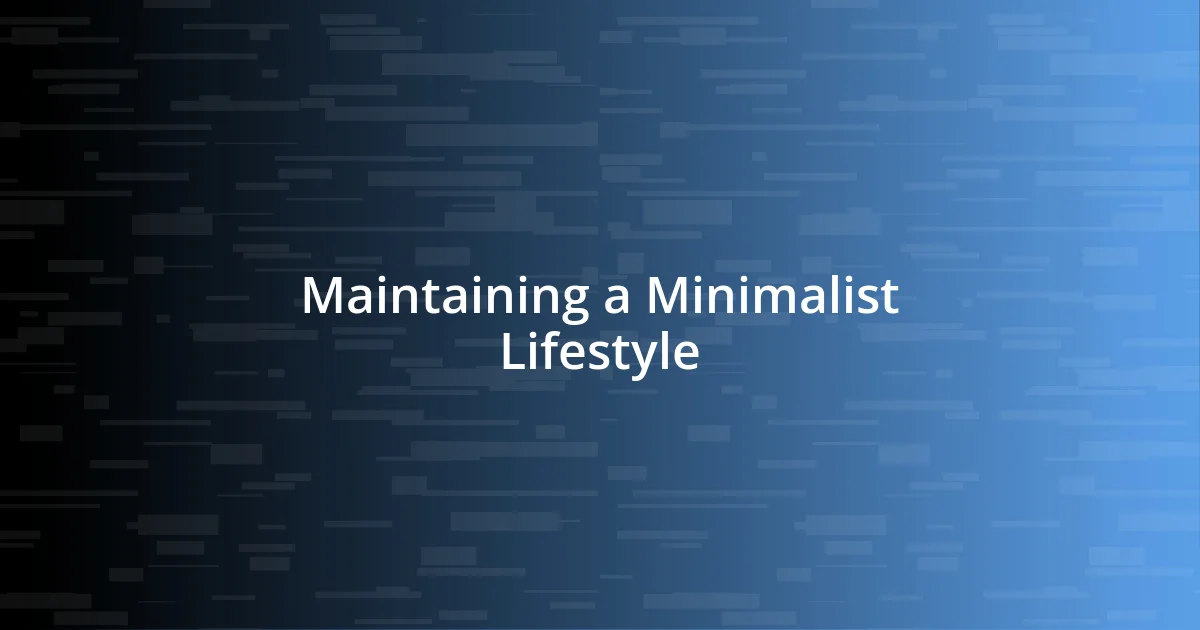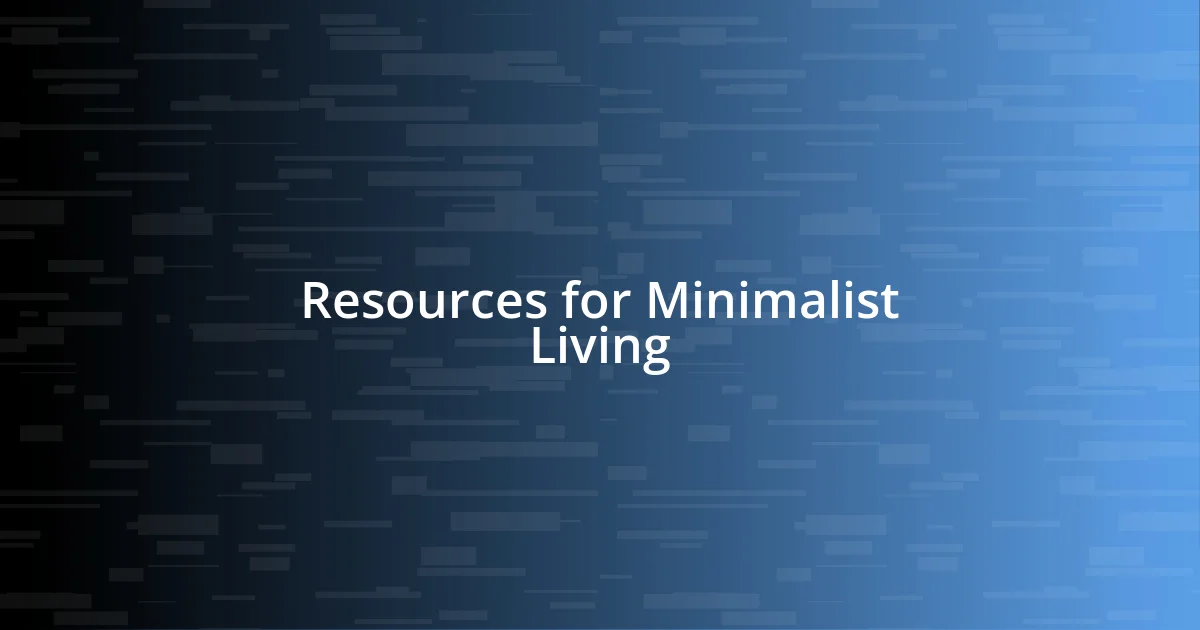Key takeaways:
- Minimalism is about aligning choices with values, focusing on experiences and relationships rather than material possessions.
- Implementing practical decluttering methods, like starting small and using the Four-Box Method, helps confront emotional attachments to belongings.
- Maintaining a minimalist lifestyle involves regular decluttering, being intentional with purchases, and seeking support from like-minded individuals.

Understanding Minimalist Lifestyle
Understanding a minimalist lifestyle goes beyond just decluttering possessions; it’s about making conscious choices that align with your values. I remember the moment I realized how overwhelmed I felt surrounded by things I didn’t even use or love. Have you ever experienced that weight of excess hanging over you?
In my journey, I discovered that minimalism isn’t simply about having less; it’s about creating space for more of what truly matters. When I let go of items that didn’t have a significant place in my life, I felt liberated. Have you ever considered what you could gain by releasing what no longer serves you?
Embracing minimalism has taught me to prioritize experiences and relationships over material possessions. I find joy in simple moments now, like a leisurely walk in nature or meaningful conversations with friends. Doesn’t it feel refreshing to think about life in terms of moments rather than things?

Steps to Declutter Your Space
When I first embarked on my decluttering journey, I found it incredibly helpful to start small. I dedicated just ten minutes each day to tackle one area of my home, be it a single drawer or a shelf. This manageable approach prevented me from feeling overwhelmed, something I often encountered when I thought about decluttering my entire space at once.
Next, I utilized the “Four-Box Method,” which is one of my favorite strategies. I set out four boxes labeled: Keep, Donate, Trash, and Relocate. Each item I encountered had to fit into one of these categories. This not only streamlined my decision-making process but also made me confront each piece in my home, leading to some surprising realizations about what I truly valued.
Lastly, I encourage you to consider the emotional weight of your belongings. As I sorted through my items, I experienced moments of nostalgia and even sadness when parting with certain things. However, I’ve learned to embrace the idea that letting go of the past makes room for new experiences. Do you feel that same pull when faced with sentimental items? It’s a challenge, but it ultimately leads to a renewed sense of clarity.
| Decluttering Methods | My Experience |
|---|---|
| Start Small | Ten minutes a day helped avoid overwhelm. |
| Four-Box Method | Clarified my thoughts on what I truly need. |
| Emotional Weight | Letting go opens up space for new experiences. |

Creating a Minimalist Routine
Creating a minimalist routine has been one of the most transformative aspects of my journey. I found that establishing a set of daily habits not only declutters my physical space but also my mental space. Incorporating simplicity into my routine allowed me to focus on what really matters, giving me a sense of peace.
Here are some key elements I’ve integrated into my minimalist routine:
- Morning Mindfulness: I start each day with a few minutes of meditation or quiet reflection. This sets a positive tone for the day.
- Simplified Meal Prep: I planned my meals for the week, which reduces food waste and helps me eat healthy. Less decision-making means more mental clarity.
- Digital Clutter Control: I unfollowed social media accounts that don’t add value to my life. This helps me stay focused on what truly interests me.
- Nightly Reflection: Each evening, I take a moment to evaluate my day. I write down what I accomplished and what I learned, which reinforces a sense of purpose.
By embracing these simple routines, I discovered that each small change creates a ripple effect, contributing to a more intentional and fulfilling lifestyle. It’s fascinating how these seemingly minor habits can lead to significant shifts in perspective, wouldn’t you agree?

Mindset Shifts for Minimalism
A significant mindset shift I had to make was understanding that less truly can be more. Initially, I equated owning more things with happiness and success. Over time, I began to recognize that my happiness didn’t stem from possessions, but rather from experiences, relationships, and the freedom that simplicity brought. Have you ever felt that rush when you clear something out? It’s liberating!
As I dug deeper into minimalism, I realized how much I clung to the idea of perfection. I once thought my space had to look flawless, which inevitably added stress. Shifting away from perfection allowed me to embrace the beauty of imperfection, teaching me that a little messiness is part of life and can even reflect genuine moments. Can you recall a time when perfectionism held you back? Letting go of that need opened up so many possibilities for me.
Another powerful change was developing gratitude for what I already have. Instead of continuously wanting more, I focused on appreciating the items that added value to my life. I started a gratitude journal, jotting down things I valued each day, which shifted my perspective immensely. This practice not only deepened my appreciation but also reinforced an intentional approach to my belongings. Isn’t it interesting how gratitude can transform our relationship with our possessions?

Maintaining a Minimalist Lifestyle
While embracing a minimalist lifestyle sounds simple, maintaining it requires ongoing effort. One way I keep on track is through regular decluttering sessions. Every few months, I take a Saturday morning to go through my belongings. Surprisingly, I often find items I’ve forgotten about, and parting with them is a relief. Have you ever experienced that lightness when you let go of something that no longer serves a purpose? It’s truly refreshing.
Another key aspect of sustaining minimalism is being intentional with my purchases. I’ve set a guideline for myself: if I want to buy something new, I must first evaluate its necessity. This process forces me to think critically about each item. When I spotted a pair of shoes during a recent shopping trip that I really liked, I hesitated. Did I need them? No. And that moment of pause made me realize how often I’d previously shopped out of impulse rather than intention.
Social influences can also add to the clutter of our lives. I’ve consciously surrounded myself with people who respect my minimalist journey, which reinforces my commitment. By engaging in conversations about living simply, I find encouragement and support. Have you connected with someone on a similar path? Sharing insights and experiences can be a powerful motivator to keep embracing minimalism. It reminds me that I’m not alone in this lifestyle choice.

Resources for Minimalist Living
When I first explored minimalist living, I turned to various online resources that provided practical tips and inspiration. Blogs like “The Minimalists” and “Becoming Minimalist” became my go-to hubs for absorbing knowledge and real-life stories. I found myself nodding along as I read their insights—hasn’t everyone felt overwhelmed by too much stuff at some point? These platforms fostered a sense of community, making me realize I was a part of a larger movement.
I also discovered podcasts that resonated with my journey, such as “The Minimalism Podcast.” Listening to discussions about decluttering and intentional living while doing mundane tasks made those moments feel purposeful. Each episode offered nuggets of wisdom that spurred my own reflections—what if I started looking at my belongings as temporary guests in my life? The conversations opened my eyes to new ways of thinking, turning mundane moments into profound realizations.
Lastly, I dove into books that shifted my perspective, especially “Essentialism” by Greg McKeown. The idea of prioritizing what truly matters struck a chord with me. As I implemented these principles, I found myself asking, “What does success actually mean to me?” Reading deeply about minimalism pushed me to redefine success beyond material accumulation. It was an empowering revelation that truly transformed how I view my possessions and my life.














